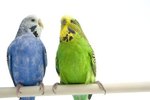Lovebirds are small parrots, belonging to the taxonomic genus Agapornis. Nine lovebird species exist, but only three are commonly kept as pets. All of these species form strong, monogamous pair bonds and generally mate for life. However, pairs of any type of lovebirds will occasionally break up if they discover that they're incompatible with one another.
Meet the Lovebirds
Eight of the nine species of lovebirds come from mainland Africa, while the ninth originates from Madagascar, an island just off the African coast. These nine species are the gray-headed lovebird (Agapornis canus), Fischer's lovebird (A. fischeri), Lilian's lovebird (A. lilianae), the black-cheeked lovebird (A. nigrigenis), the yellow-collared lovebird (A. personatus), the red-headed lovebird (A. pullarius), the rosy-faced lovebird (A. roseicollis), the black-collared lovebird (A. swindernianus) and the black-winged lovebird (A. taranta). They usually inhabit savannas and dry forests, but they're occasionally found in rain forests.
Finding a Mate
Each of the different lovebirds have their own ways of finding their mate, but some similarities exist between species. Mating -- or pairing -- rituals can start young; for instance, rosy-faced lovebirds start pair bonding as young as 2 months old. In all species, males are the ones who must display to their potential mates, whereas the female lovebirds are dominant and will accept or reject the males. Mating rituals often involve the males offering food to the females, in addition to displays of head-bobbing and twittering calls.
Wild Behavior
In the wild, lovebirds live in flocks which can be small -- containing just a few pairs -- or very large -- containing up to 800 individuals. These larger flocks tend to gather around sources of food or water during the dry season, when resources are more scarce. These social birds communicate with one another using a series of vocalizations, for breeding purposes and to warn others of potential danger. These birds are primarily herbivores -- eating seeds, nuts, fruits, berries and flowers -- but may eat the occasional insect.
Lovebirds as Pets
Only three of the nine lovebird species are commonly kept as pets: Fischer's lovebirds, rosy-faced lovebirds and yellow-collared lovebirds. The remaining species don't thrive in captivity and it's hard or impossible to keep them happy and healthy. Contrary to popular belief, it's not necessary to keep lovebirds in pairs, they will be happy kept alone. If you have just one lovebird, he's likely to be more tame and friendly toward you, but you will have to socialize with him often. However, many people enjoy keeping these birds in pairs as they'll spend much of their time snuggling up together and preening one another, which can be a pleasure to watch.





